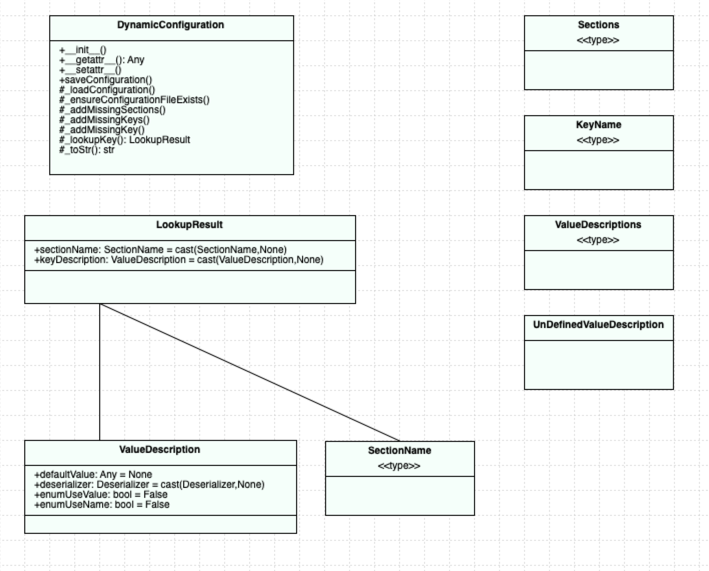◎欢迎参与讨论,请在这里发表您的看法、交流您的观点。
迈向轻松的 Python 配置文件版本 3
ID:21737 / 打印介绍
这是本系列的最后一篇文章。 此实现旨在修复我在上一篇文章中描述的样板代码的主要缺点。 我将此实现称为动态属性类。
班级代表
以下类图显示了 dynamicconfiguration 可重用类以及开发人员使用此功能所需的支持数据结构。 它仍然提供版本 2 的所有基本功能,包括自动启动捆绑、创建缺失部分和键值。

开发者代码说明
我将展示寻求使用此类的应用程序的完整源代码。 我正在使用我们在前 3 篇文章中讨论过的属性。
from codeallybasic.dynamicconfiguration import dynamicconfiguration from codeallybasic.dynamicconfiguration import keyname from codeallybasic.dynamicconfiguration import sectionname from codeallybasic.dynamicconfiguration import sections from codeallybasic.dynamicconfiguration import valuedescription from codeallybasic.dynamicconfiguration import valuedescriptions from codeallybasic.secureconversions import secureconversions from codeallybasic.singletonv3 import singletonv3 from bytesizedpython.impostorenumbyname import impostorenumbyname from bytesizedpython.phoneyenumbyvalue import phoneyenumbyvalue logger_name: str = 'tutorial' base_file_name: str = 'config.ini' module_name: str = 'version3properties' default_phoney_enum_by_value: phoneyenumbyvalue = phoneyenumbyvalue.fakebrenda default_impostor_enum_by_name: impostorenumbyname = impostorenumbyname.high general_properties: valuedescriptions = valuedescriptions( { keyname('debug'): valuedescription(defaultvalue='false', deserializer=secureconversions.secureboolean), keyname('loglevel'): valuedescription(defaultvalue='info'), keyname('phoneyenumbyvalue'): valuedescription(defaultvalue=default_phoney_enum_by_value.value, enumusevalue=true), keyname('impostorenumbyname'): valuedescription(defaultvalue=default_impostor_enum_by_name.name, enumusename=true), } ) database_properties: valuedescriptions = valuedescriptions( { keyname('dbname'): valuedescription(defaultvalue='dbname'), keyname('dbhost'): valuedescription(defaultvalue='localhost'), keyname('dbport'): valuedescription(defaultvalue='5342', deserializer=secureconversions.secureinteger), } ) configuration_sections: sections = sections( { sectionname('general'): general_properties, sectionname('database'): database_properties, } ) class configurationpropertiesversion3(dynamicconfiguration, metaclass=singletonv3): def __init__(self): self._logger: logger = getlogger(logger_name) super().__init__(basefilename=base_file_name, modulename=module_name, sections=configuration_sections) 第 45-50 行是您必须编写的代码。 本质上,您只需确保传递文件名、模块名称和配置部分。 这个sections类型来自dynamicconfiguration模块。
第 21-28 行和第 30-36 行是 valuedescriptions 字典。 keyname 是属性并指向 valuedescription。 请注意,有关如何持久化枚举的指示符已从先前实现的装饰器移至 valuedescription 中的布尔属性。
立即学习“Python免费学习笔记(深入)”;
实现代码说明
如果仔细查看 dynamicconfiguration 的类图,您会发现它实现了两个 python magic 方法。 它们是 __getattr__(self, name)__ 和 __setattr__(self, name, value)__ 方法。
- __getattr__(self, name)__ 允许开发人员定义当类使用者尝试访问不存在的属性时的行为。
- __setattr__(self, name, value)__ 允许开发人员定义分配给属性的行为。
以下是 __getattr__ 的代码。 这看起来非常像我们在版本 2 中使用的装饰器。关键工作发生在第 14 行对受保护方法 _lookupkey() 的调用上。 它返回属性的完整描述,以便我们可以模拟属性检索。
def __getattr__(self, attrname: str) -> any: """ does the work of retrieving the named attribute from the configuration parser args: attrname: returns: the correctly typed value """ self._logger.info(f'{attrname}') configparser: configparser = self._configparser result: lookupresult = self._lookupkey(searchkeyname=keyname(attrname)) valuedescription: valuedescription = result.keydescription valuestr: str = configparser.get(result.sectionname, attrname) if valuedescription.deserializer is not none: value: any = valuedescription.deserializer(valuestr) else: value = valuestr return value 以下是 __setattr__() 的实现。 请注意第 22-27 行中对枚举的支持以及第 30 行中的 直写 功能。
def __setattr__(self, key: str, value: any): """ do the work of writing this back to the configuration/settings/preferences file ignores protected and private variables uses by this class does a "write through" to the backing configuration file (.ini) args: key: the property name value: its new value """ if key.startswith(protected_property_indicator) or key.startswith(private_property_indicator): super(dynamicconfiguration, self).__setattr__(key, value) else: self._logger.debug(f'writing `{key}` with `{value}` to configuration file') configparser: configparser = self._configparser result: lookupresult = self._lookupkey(searchkeyname=keyname(key)) valuedescription: valuedescription = result.keydescription if valuedescription.enumusevalue is true: valuestr: str = value.value configparser.set(result.sectionname, key, valuestr) elif valuedescription.enumusename is true: configparser.set(result.sectionname, key, value.name) else: configparser.set(result.sectionname, key, str(value)) self.saveconfiguration() 访问和修改属性
访问和修改属性与版本 2 完全相同。
basicconfig(level=info) config: configurationpropertiesversion2 = configurationpropertiesversion2() logger: logger = getlogger(logger_name) logger.info(f'{config.debug=}') logger.info(f'{config.loglevel=}') logger.info(f'{config.phoneyenumbyvalue=}') logger.info(f'{config.impostorenumbyname=}') logger.info('database properties follow') logger.info(f'{config.dbname=}') logger.info(f'{config.dbhost=}') logger.info(f'{config.dbport=}') logger.info('mutate enumeration properties') config.phoneyenumbyvalue = phoneyenumbyvalue.thewanderer logger.info(f'{config.phoneyenumbyvalue=}') config.impostorenumbyname = impostorenumbyname.low logger.info(f'{config.impostorenumbyname=}') 上面的代码片段产生以下输出。
INFO:Tutorial:config.debug='False' INFO:Tutorial:config.logLevel='Info' INFO:Tutorial:config.phoneyEnumByValue=<PhoneyEnumByValue.FakeBrenda: 'Faker Extraordinaire'> INFO:Tutorial:config.impostorEnumByName='High' INFO:Tutorial:Database Properties Follow INFO:Tutorial:config.dbName='example_db' INFO:Tutorial:config.dbHost='localhost' INFO:Tutorial:config.dbPort=5432 INFO:Tutorial:Mutate Enumeration Properties INFO:Tutorial:config.phoneyEnumByValue=<PhoneyEnumByValue.TheWanderer: 'The Wanderer'> INFO:Tutorial:config.impostorEnumByName='Low'
结论
本文的源代码在这里。 请参阅支持类 singletonv3。 查看
的实现优点
- 轻松类型安全地访问应用程序属性
- 用于不同实现的可重用父类
- 数据结构驱动的代码,用于添加新部分和配置键
- 没有属性的样板代码
缺点
- 由于没有实现任何实际属性,我们没有获得 ide 对它们的支持
- 另外,由于键的查找方法,不同部分中的不同键不能具有相同的名称
